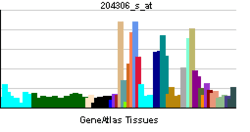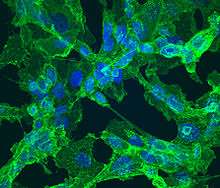CD151
| CD151 | |||||||||||||||||
|---|---|---|---|---|---|---|---|---|---|---|---|---|---|---|---|---|---|
| Identifiers | |||||||||||||||||
| Aliases | CD151, GP27, MER2, PETA-3, RAPH, SFA1, TSPAN24, CD151 molecule (Raph blood group) | ||||||||||||||||
| External IDs | OMIM: 602243 MGI: 1096360 HomoloGene: 20916 GeneCards: CD151 | ||||||||||||||||
| |||||||||||||||||
| RNA expression pattern | |||||||||||||||||
 | |||||||||||||||||
| More reference expression data | |||||||||||||||||
| Orthologs | |||||||||||||||||
| Species | Human | Mouse | |||||||||||||||
| Entrez | |||||||||||||||||
| Ensembl | |||||||||||||||||
| UniProt | |||||||||||||||||
| RefSeq (mRNA) | |||||||||||||||||
| RefSeq (protein) |
| ||||||||||||||||
| Location (UCSC) | Chr 11: 0.83 – 0.84 Mb | Chr 7: 141.47 – 141.47 Mb | |||||||||||||||
| PubMed search | [1] | [2] | |||||||||||||||
| Wikidata | |||||||||||||||||
| View/Edit Human | View/Edit Mouse |
CD151 molecule (Raph blood group), also known as CD151 (Cluster of Differentiation 151), is a human gene.[3]
Function
The protein encoded by this gene is a member of the transmembrane 4 superfamily, also known as the tetraspanin family. Most of these members are cell-surface proteins that are characterized by the presence of four hydrophobic domains. The proteins mediate signal transduction events that play a role in the regulation of cell development, activation, growth and motility. This encoded protein is a cell surface glycoprotein that is known to complex with integrins and other transmembrane 4 superfamily proteins. It is involved in cellular processes including cell adhesion and may regulate integrin trafficking and/or function. This protein enhances cell motility, invasion and metastasis of cancer cells. Multiple alternatively spliced transcript variants that encode the same protein have been described for this gene.[3]
Interactions

CD151 has been shown to interact with CD46.[4]
See also
References
- ↑ "Human PubMed Reference:".
- ↑ "Mouse PubMed Reference:".
- 1 2 "Entrez Gene: CD151 CD151 molecule (Raph blood group)".
- ↑ Lozahic S, Christiansen D, Manié S, Gerlier D, Billard M, Boucheix C, Rubinstein E (March 2000). "CD46 (membrane cofactor protein) associates with multiple beta1 integrins and tetraspans". Eur. J. Immunol. 30 (3): 900–7. doi:10.1002/1521-4141(200003)30:3<900::AID-IMMU900>3.0.CO;2-X. PMID 10741407.
Further reading
- Berditchevski F (2002). "Complexes of tetraspanins with integrins: more than meets the eye". J. Cell. Sci. 114 (Pt 23): 4143–51. PMID 11739647.
- Ashman LK (2003). "CD151". J. Biol. Regul. Homeost. Agents. 16 (3): 223–6. PMID 12456024.
- Ashman LK, Aylett GW, Mehrabani PA, Bendall LJ, Niutta S, Cambareri AC, Cole SR, Berndt MC (1992). "The murine monoclonal antibody, 14A2.H1, identifies a novel platelet surface antigen". Br. J. Haematol. 79 (2): 263–70. doi:10.1111/j.1365-2141.1991.tb04531.x. PMID 1958484.
- Fitter S, Tetaz TJ, Berndt MC, Ashman LK (1995). "Molecular cloning of cDNA encoding a novel platelet-endothelial cell tetra-span antigen, PETA-3". Blood. 86 (4): 1348–55. PMID 7632941.
- Maruyama K, Sugano S (1994). "Oligo-capping: a simple method to replace the cap structure of eukaryotic mRNAs with oligoribonucleotides". Gene. 138 (1–2): 171–4. doi:10.1016/0378-1119(94)90802-8. PMID 8125298.
- Hasegawa H, Utsunomiya Y, Kishimoto K, Yanagisawa K, Fujita S (1996). "SFA-1, a novel cellular gene induced by human T-cell leukemia virus type 1, is a member of the transmembrane 4 superfamily". J. Virol. 70 (5): 3258–63. PMC 190191
 . PMID 8627808.
. PMID 8627808. - Hasegawa H, Kishimoto K, Yanagisawa K, Terasaki H, Shimadzu M, Fujita S (1997). "Assignment of SFA-1 (PETA-3), a member of the transmembrane 4 superfamily, to human chromosome 11p15.5 by fluorescence in situ hybridization". Genomics. 40 (1): 193–6. doi:10.1006/geno.1996.4563. PMID 9070943.
- Sincock PM, Mayrhofer G, Ashman LK (1997). "Localization of the transmembrane 4 superfamily (TM4SF) member PETA-3 (CD151) in normal human tissues: comparison with CD9, CD63, and alpha5beta1 integrin". J. Histochem. Cytochem. 45 (4): 515–25. doi:10.1177/002215549704500404. PMID 9111230.
- Suzuki Y, Yoshitomo-Nakagawa K, Maruyama K, Suyama A, Sugano S (1997). "Construction and characterization of a full length-enriched and a 5'-end-enriched cDNA library". Gene. 200 (1–2): 149–56. doi:10.1016/S0378-1119(97)00411-3. PMID 9373149.
- Fitter S, Seldin MF, Ashman LK (1998). "Characterisation of the mouse homologue of CD151 (PETA-3/SFA-1); genomic structure, chromosomal localisation and identification of 2 novel splice forms". Biochim. Biophys. Acta. 1398 (1): 75–85. doi:10.1016/S0167-4781(98)00034-7. PMID 9602068.
- Sincock PM, Fitter S, Parton RG, Berndt MC, Gamble JR, Ashman LK (1999). "PETA-3/CD151, a member of the transmembrane 4 superfamily, is localised to the plasma membrane and endocytic system of endothelial cells, associates with multiple integrins and modulates cell function". J. Cell. Sci. 112 ( Pt 6): 833–44. PMID 10036233.
- Serru V, Le Naour F, Billard M, Azorsa DO, Lanza F, Boucheix C, Rubinstein E (1999). "Selective tetraspan-integrin complexes (CD81/alpha4beta1, CD151/alpha3beta1, CD151/alpha6beta1) under conditions disrupting tetraspan interactions". Biochem. J. 340 (1): 103–11. doi:10.1042/0264-6021:3400103. PMC 1220227
 . PMID 10229664.
. PMID 10229664. - Testa JE, Brooks PC, Lin JM, Quigley JP (1999). "Eukaryotic expression cloning with an antimetastatic monoclonal antibody identifies a tetraspanin (PETA-3/CD151) as an effector of human tumor cell migration and metastasis". Cancer Res. 59 (15): 3812–20. PMID 10447000.
- Sterk LM, Geuijen CA, Oomen LC, Calafat J, Janssen H, Sonnenberg A (2000). "The tetraspan molecule CD151, a novel constituent of hemidesmosomes, associates with the integrin alpha6beta4 and may regulate the spatial organization of hemidesmosomes". J. Cell Biol. 149 (4): 969–82. doi:10.1083/jcb.149.4.969. PMC 2174566
 . PMID 10811835.
. PMID 10811835. - Whittock NV, McLean WH (2001). "Genomic organization, amplification, fine mapping, and intragenic polymorphisms of the human hemidesmosomal tetraspanin CD151 gene". Biochem. Biophys. Res. Commun. 281 (2): 425–30. doi:10.1006/bbrc.2001.4384. PMID 11181065.
- Charrin S, Le Naour F, Oualid M, Billard M, Faure G, Hanash SM, Boucheix C, Rubinstein E (2001). "The major CD9 and CD81 molecular partner. Identification and characterization of the complexes". J. Biol. Chem. 276 (17): 14329–37. doi:10.1074/jbc.M011297200. PMID 11278880.
- Suzuki Y, Tsunoda T, Sese J, Taira H, Mizushima-Sugano J, Hata H, Ota T, Isogai T, Tanaka T, Nakamura Y, Suyama A, Sakaki Y, Morishita S, Okubo K, Sugano S (2001). "Identification and characterization of the potential promoter regions of 1031 kinds of human genes". Genome Res. 11 (5): 677–84. doi:10.1101/gr.164001. PMC 311086
 . PMID 11337467.
. PMID 11337467. - Kohno M, Hasegawa H, Miyake M, Yamamoto T, Fujita S (2002). "CD151 enhances cell motility and metastasis of cancer cells in the presence of focal adhesion kinase". Int. J. Cancer. 97 (3): 336–43. doi:10.1002/ijc.1605. PMID 11774285.
- Zhang XA, Kazarov AR, Yang X, Bontrager AL, Stipp CS, Hemler ME (2002). "Function of the tetraspanin CD151-alpha6beta1 integrin complex during cellular morphogenesis". Mol. Biol. Cell. 13 (1): 1–11. doi:10.1091/mbc.01-10-0481. PMC 65068
 . PMID 11809818.
. PMID 11809818.
External links
- Raph blood group system in the BGMUT blood group antigen gene mutation database
This article incorporates text from the United States National Library of Medicine, which is in the public domain.